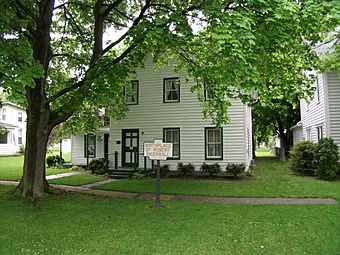Robert Ingersoll Birthplace facts for kids
Quick facts for kids |
|
|
Robert Ingersoll Birthplace
|
|

Robert Ingersoll Birthplace, May 2011
|
|
| Location | Main St., Dresden, New York |
|---|---|
| Area | less than one acre |
| Built | 1833 |
| Architectural style | Federal |
| NRHP reference No. | 88000110 |
| Added to NRHP | February 11, 1988 |
The Robert Ingersoll Birthplace, also known as the Robert Green Ingersoll Birthplace Museum, is a special old house in Dresden, New York. It is built in the Federal style, which was popular a long time ago. This two-story house has a main part and a smaller section called an ell.
This house is famous because it is where Robert G. Ingersoll was born in 1833. He grew up to be a well-known politician and a speaker who shared his ideas about life and religion. The house was added to the National Register of Historic Places in 1988, recognizing its importance in history.
The Story of the House
The main part of this house was first built around 1800. It served as a parsonage, which is a home for a church minister, for the Congregational church. This part of the house was originally on a different street in Dresden. It was built with materials that people donated and by volunteers who helped construct it.
Another part of the house, the front section of the ell, was also built around 1800. It came from a nearby settlement called Hopeton, which later disappeared. Many buildings from Hopeton were moved to Dresden, probably by sliding them on sledges during a snowy winter. The main part of the house and the front ell were joined together on the current Main Street spot before 1833. Later, the back part of the ell was added to the house at its present location.
Who Was Robert Ingersoll?
Robert Green Ingersoll was born in this house in 1833. His father, Rev. John Ingersoll, was the pastor of Dresden's Congregational Church at the time. The family lived in the parsonage. Rev. Ingersoll was a strong abolitionist, meaning he believed slavery should be ended, even before it was a popular idea.
Because of his strong beliefs, Rev. Ingersoll often moved to new churches. The Ingersolls left Dresden when Robert was only four months old. Even though he lived there for such a short time, this house is very important. It is the only one of Robert Ingersoll's homes that is still standing today. Because of this, people who admired Ingersoll have celebrated this house since he passed away in 1899.
After Ingersoll's death, his brother-in-law started a company named Dresden Publishing Company. This company published all of Ingersoll's speeches and writings. The first book even had a picture of his birthplace. The house has been opened as a museum three times. In 1921, famous people like Thomas Edison and Luther Burbank helped open it as a museum, community center, and library. It closed during the Great Depression. In 1954, another group led by Joseph L. Lewis restored it again and ran it as a museum for several years.
The Museum Today
The Robert Green Ingersoll Birthplace Museum is a special place that teaches visitors about Ingersoll's life and ideas. Tom Flynn helped create this museum and was its director from 1993 until 2021.
In 1986, the house was in poor condition. A group called CODESH Inc. (now known as the Council for Secular Humanism) bought the property. They worked hard to get it listed on the National Register of Historic Places. They raised a lot of money to fix up the house between 1987 and 1991. In 1992, they decided to open a museum there, and Tom Flynn was chosen to develop it. Flynn once said that Ingersoll was heard by more Americans than almost anyone else before movies or radio existed!
The museum officially opened on Memorial Day weekend in 1993. It has been open to the public on weekends during the summer and fall ever since. Over the years, many new things have been added. In 2001, a large statue of Ingersoll was installed. In 2003, a historically accurate front porch was added by a volunteer who was also an Ingersoll descendant. That same year, the museum started using the tagline: "the most remarkable American most people never heard of." This refers to how some people tried to erase Ingersoll from history.
In 2004, a lost piece of music called Ingersolia was found and its score was displayed. In 2005, two websites were launched: a virtual tour of the museum and a guide to other historical sites nearby. In 2008, a special plaque from Ingersoll's New York City home was moved to the museum. In 2009, a new video about Ingersoll was installed, featuring the Ingersolia March. Also in 2009, the museum received many items and papers from Ingersoll's last surviving granddaughter, Eva Ingersoll Wakefield. Some of these items were put on display starting in 2010.
In 2014, the inside of the museum was completely updated. Display cases were improved, and new signs and large wall graphics were added. A room on the second floor that used to be private was opened to the public. This new interior was named the T. M. Scruggs Museum Interior, honoring a generous donor who helped fund the renovation.
Images for kids

















